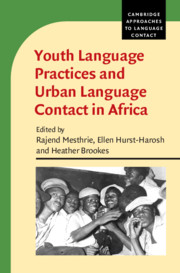Book contents
- Youth Language Practices and Urban Language Contact in Africa
- Cambridge Approaches to Language Contact
- Youth Language Practices and Urban Language Contact in Africa
- Copyright page
- Contents
- Figures
- Tables
- Contributors
- Series Editor’s Foreword
- Preface
- Abbreviations
- Introduction
- 1 Language Contact and Structure in Urban IsiXhosa and Associated Youth Languages
- 2 Not ‘Deep’ but Still IsiXhosa:
- 3 Rethinking Youth Language Practices in South Africa:
- 4 Tsotsitaals, Urban Vernaculars and Contact Linguistics
- 5 Grammatical Hybridity in Camfranglais?
- 6 Sheng and Engsh in Kenya’s Public Spaces and Media
- 7 Exploring Hybridity in Ivorian French and Nouchi
- 8 Authenticity and the Object of Analysis:
- Index
- References
Introduction
Published online by Cambridge University Press: 20 August 2021
- Youth Language Practices and Urban Language Contact in Africa
- Cambridge Approaches to Language Contact
- Youth Language Practices and Urban Language Contact in Africa
- Copyright page
- Contents
- Figures
- Tables
- Contributors
- Series Editor’s Foreword
- Preface
- Abbreviations
- Introduction
- 1 Language Contact and Structure in Urban IsiXhosa and Associated Youth Languages
- 2 Not ‘Deep’ but Still IsiXhosa:
- 3 Rethinking Youth Language Practices in South Africa:
- 4 Tsotsitaals, Urban Vernaculars and Contact Linguistics
- 5 Grammatical Hybridity in Camfranglais?
- 6 Sheng and Engsh in Kenya’s Public Spaces and Media
- 7 Exploring Hybridity in Ivorian French and Nouchi
- 8 Authenticity and the Object of Analysis:
- Index
- References
Summary
This book aims to expand on theoretical developments in the sociolinguistic subfield of youth language, concentrating on data and research from the African continent. Twentieth-century developments like urbanisation, particular kinds of multilingualism and the rapidly increased proportion of young people in urban centres have made this a growing area of research. Urban centres are characterised by the presence of numerous national, official and vernacular languages. Diversity increases with migration from rural areas due to the underdevelopment of rural economies and a lack of paid employment in those areas. Equally significant are cross-border migration and cross-continental mobility due to economic and political factors. To cite the numbers of languages in three of the countries that feature in this book: Kenya has as many as 69 languages, Cameroon has 230 and Côte d’Ivoire has 60. This multitude of local languages coexist in major cities with colonial languages – French, English and Portuguese in most cases (Lewis, 2009). McLaughlin (2009: 2) describes the extent of societal multilingualism on the continent and suggests that it is intensified in the cities. In Abidjan, the largest city in Côte d’Ivoire, the last few decades of increased migration from rural areas and from neighbouring countries has led to a situation where 30 per cent of the current population are non-Ivorian, and the Ivorians are represented by 60 native ethnic groups with a diversity of languages (Kube-Barth, 2009). Since 1950, the urban percentage of the population in sub-Saharan Africa increased from 11 to 39 per cent in 2015 (United Nations, 2018). Based on World Bank data from 2017, the urban annual growth rate in sub-Saharan Africa ranged from 1.4 to 5.7 per cent, with the urban population of 427 million predicted to double in the next 25 years (Saghir and Santoro, 2018).
- Type
- Chapter
- Information
- Publisher: Cambridge University PressPrint publication year: 2021

